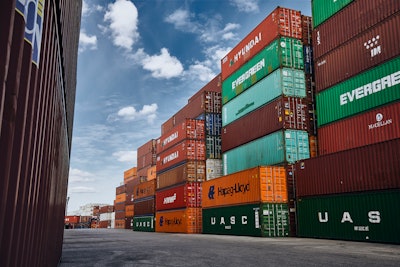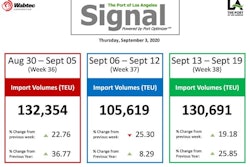
As consumer demand for fresh foods grows, maintaining the right environmental conditions during transport of perishable items is vital. Today’s reefer containers offer sophisticated environmental controls that can optimize the freshness of perishable cargo. But, if containers are mis-used or exposed to adverse conditions, the resulting claims can be very expensive.
For instance, the majority of insurance claims TT Club receives for perishable cargo are the result of three things:
- Confusion over Celsius and Fahrenheit;
- Poor communication of shipping requirements;
- Failure to monitor or plug in the cargo transport unit throughout its journey.
While it’s important for shippers to accurately communicate handling instructions, it’s virtually impossible to guarantee the instructions will be followed. Equipment malfunctions and human error during the journey may also expose perishable items to sub-optimal conditions. Reefer containers are particularly vulnerable at hand-off points, which typically occur at the ship-port interface during transfer of containers to/from port by truck, rail or inland waterway—or vice versa from origin to outbound port. Bill of lading hand-off at these points has been a particular issue during the Coronavirus disease (COVID-19) pandemic. Currently, goods are getting stuck in port waiting for paperwork to be delivered by flights that have been delayed.
Remote control of cold chain excellence
Ideally, shippers of perishable goods would be able to maintain cold chain excellence in spite of problems that occur en route. Internet of Things (IoT) technology holds the promise of allowing this level of supervision and control. Integrated IoT technology can stream real-time data from connected devices, providing end-to-end visibility into both the whereabouts of containers and the status of their contents.
Applications can use this data to warn if certain thresholds are violated at any point along the container journey. Shippers would not only be able to make informed, data-driven decisions about the status of their shipments, but they would also have the power to adjust environmental and other controls remotely. Imagine receiving a warning on your smartphone that your container of avocados is five degrees too warm two hours after leaving port, and then being able to diagnose the problem and/or lower the temperature yourself. Being able to provide this level of data to cross-border authorities may also potentially reduce the number of inspections and delays.
If this is the end game, what are the steps involved in getting there?
The state of IoT solutions for container shipping
Solutions providers are developing IoT solutions for container shipping, and carriers are adopting them. Several large companies have adopted various solutions to help them deploy IoT devices across their fleets. But, full intermodal communication and connectivity remain an issue. Many existing IoT solutions don’t interoperate with all the various internet or radio communication protocols in use, and thus, their scope and reach are limited.
Achieving an uninterrupted stream of relevant container information across the entire transportation journey requires uninterrupted communication across all channels—satellite, cellular, radio, wireless, Bluetooth and more. Currently, the lack of interoperability between different IoT solutions has created “blind spots” along the end-to-end container journey that no proprietary IoT solution is likely to resolve.
For one, it is not realistic for a single solution provider to develop an IoT solution capable of operating across every communication protocol that exists in the supply chain. Achieving full interoperability requires a technological foundation that will smooth the way for seamless data communication from end to end.
The need for standards
Without standards for wireless communication, smartphones would be almost useless. You wouldn’t be able to call someone who uses a different phone service, connect to the Internet via a Wi-Fi network or stream music to a Bluetooth headset. Standards are required to enable seamless switching from communication channel to communication channel. Standards provide the essential rules that enable hardware and software to work together to allow devices to send data over the various protocols in a network.
As with a smartphone network, standards are needed to send data safely and seamlessly across a network of IoT devices in container transportation. To create these standards, there are three aspects of the network infrastructure that need to be defined and aligned:
1. Data communication protocols. Aligning these ensures that data can flow seamlessly from channel to channel.
2. Data structure and handling requirements. Defining these ensures that all data inputs and outputs (such as temperature, location, container status, etc.) use a format the system can understand, so data can be exchanged correctly.
3. Security requirements. IoT systems are inherently vulnerable to cyberattacks. Defining physical and software security requirements will create trust that IoT systems can be used safely.
The role of DCSA
As a standards body with nine of the Top 11 ocean carriers as members, Digital Container Shipping Association (DCSA) aims to create standards that will enable interoperability of IoT solutions across these key aspects. In June, DCSA published its first set of IoT standards. These align data communication protocols between smart container solutions and gateways at vessels, ports, terminals and container depots at the physical level. These standards will enable radio communication during the journey at sea, on land and at the vulnerable port interface points. In subsequent releases, DCSA will publish standards for additional communication protocols, data structure and handling and minimum requirements for physical/software security for IoT devices. Once in place, these standards will enable uninterrupted, end-to-end communication between smart containers and mobile devices such as smartphones.
Standards-compliant mobile apps analyse container data to provide a raft of innovative capabilities. In addition to monitoring things like temperature, humidity, oxygen and C02 levels, smart container alerts advise of mishandling or equipment failures (reefers in particular) or assist in locating dangerous goods to enhance safety. Terminal operators verify the exact location of each container in their yard efficiently and in real time. With continuous monitoring, it will be easier to make people liable for negligence and a host of other new services.
An investment in the future
Standards are not only important for maintaining the quality of perishable items for shippers, but they are also a smart investment for every stakeholder in the supply chain. DCSA standards are vendor and platform agnostic, which means not only do they work with other standards; they mitigate the risk of investing in a particular IoT technology. No matter which vendor you choose for IoT solutions, you can be guaranteed they will interoperate with other compliant solutions on the market. DCSA standards enable any stakeholder in transportation, including ports, terminals, truckers and railways, to invest in an IoT infrastructure that is backed by the major shipping lines.
Ultimately, having a standards-based technology foundation for IoT solutions will provide more value to the end customer while increasing the efficiency of container operations. DCSA gives the industry a framework for interoperability that allows stakeholders to create innovative IoT solutions that can be leveraged by any industry stakeholder or service provider. This allows carriers and other supply chain participants to focus on providing more valuable services and a better experience to their customers.





















